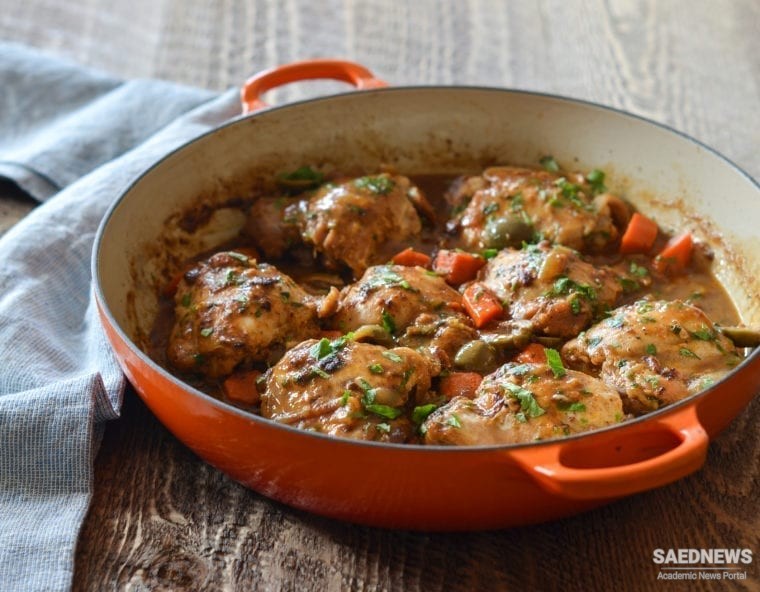The tagine doubles as both a cooking vessel and a serving dish that keeps the food warm. Dishes served in a tagine are traditionally eaten communally; diners gather around the tagine and eat by hand, using pieces of Moroccan bread to scoop up meat, vegetables, and sauce. Since you won't be stirring during the cooking, take care how you arrange or layer ingredients for a beautiful table presentation.
Tagines are most often used on the stovetop but can also be placed in the oven. When cooking with a tagine on the stovetop, the use of an inexpensive diffuser between the tagine and the heat source is essential. A diffuser is a flat metal paddle that sits between the burner and the tagine and, as the name says, diffuses the heat so the ceramic doesn't crack and break.
Ingredients:
- 1 teaspoon paprika
- 1 teaspoon ground cumin
- 1/4 teaspoon cayenne pepper
- 1/2 teaspoon ground ginger
- 1/2 teaspoon ground coriander
- 1/4 teaspoon ground cinnamon
- 1 lemon
- 5 cloves garlic, minced
- 8 bone-in, skin-on chicken thighs (about 4 pounds), trimmed of excess skin and fat (see note)
- Salt and ground black pepper
- 1 tablespoon olive oil
- 1 large yellow onion, halved and cut into 1/4-in-thick slices
- 2 tablespoons all-purpose flour
- 1-3/4 cups chicken broth
- 2 tablespoons honey
- 2 large or 3 medium carrots, peeled and cut crosswise into 1/2-inch-thick coins
- 1/2 cup Greek cracked green olives, pitted and halved (see note)
- 2 tablespoons chopped fresh cilantro leaves
Instructions:
- Combine the spices in a small bowl and set aside. Zest the lemon. Combine 1 teaspoon of the lemon zest with 1 minced garlic clove; set aside.
- Season both sides of chicken pieces with 2 teaspoons salt and 1/2 teaspoon pepper. Heat the oil in a large heavy-bottomed Dutch oven or pan over medium-high heat until beginning to smoke. Brown the chicken pieces skin side down in single layer until deep golden, about 5 minutes; using tongs, flip the chicken pieces over and brown the other side, about 4 minutes more. Transfer the chicken to a large plate; when cool enough to handle, peel off the skin and discard. Pour off and discard all but 1 tablespoon of fat from the pan.
- Reduce the heat to medium. Add the onion and cook, stirring occasionally, until they have browned at the edges but still retain their shape, 5 to 7 minutes (add a few tablespoons of water now and then if the pan gets too dark). Add the remaining minced garlic and cook, stirring, until fragrant, about 30 seconds. Add the spices and flour and cook, stirring constantly, until fragrant, about 30 seconds. Stir in the broth, honey, remaining lemon zest, and 1/4 teaspoon salt, scraping the bottom of the pan with a wooden spoon to loosen any browned bits. Add the chicken (with any accumulated juices) back in, reduce the heat to medium-low, cover and simmer for 10 minutes.
- Add the carrots, cover, and simmer until the chicken is cooked through and the carrots are tender-crisp, about 10 minutes more.
- Stir in the olives, reserved lemon zest-garlic mixture, cilantro, and 1 tablespoon of the lemon juice; taste the sauce and adjust seasoning with salt, pepper, and more lemon juice, if desired. Serve with couscous.
- Note: Don't fret too much over trimming the chicken thighs. The skin gets removed midway through the cooking process and most of the fat will cook off and get drained. I usually just take kitchen shears and quickly snip off any excess skin or fat. Cracked green olives are olives that have been ‘cracked’ or split open before curing, allowing the brine or marinade to penetrate. You can find them in your supermarket’s olive bar, or substitute any green olive that you like.
- Make-Ahead: After you have completed the step of cooking the carrots, the dish can be refrigerated for up to 2 days. To serve, gently warm on the stove until the chicken is heated through, then proceed to the step where the olives and remaining ingredients are added.


 Matbucha—Moroccan Tomato and Pepper Salad
Matbucha—Moroccan Tomato and Pepper Salad














































